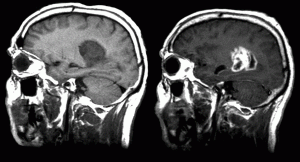Glioblastoma has an incidence and mortality of 12,000 Americans every year, which has remained constant during the last few decades despite progress in diagnostics, surgery and cancer therapies. It is the most lethal of brain malignancies, and is at present incurable (0% survival rate after 5 years).
Gadolinium Synchrotron Sterotactic Radiotherapy (GdSSR) is a novel therapy concept for curing glioblastoma, which was recently introduced by Professor Gilbert1,2 , in collaboration with François Estève2. The therapy is based on the i.v. injection of a tumor-seeking Gd compound, and subsequent exposure of the patient to a 51-keV x-ray beam, while the patient sits in a chair rotating around a vertical axis, passing through the glioblastoma (stereotactic irradiation). Because these high-energy x-rays interact very weakly with matter in general and tissue in particular, the entire skull is transparent to them. Only the gadolinium-containing glioblastoma strongly absorbs them. In fact the 51-keV photon energy was selected to be at the maximum Gd absorption (its K-edge). Photon absorption stimulates the photoelectric effect, which in turn results in Auger electron emission, without other undesirable byproducts. The choice of hard x-rays, with monochromatic energy and stereotactic irradiation all concur to a very favorable deposition of high energy in the tumor and low energy in the normal brain. Side effects for the patient, therefore, are as low as reasonably achievable. GdSSR is the natural evolution of a previous therapy3,4,5 (GdNCT), with the same desirable components (the production of Auger electrons in the nuclei of cancer cells) but does not involve any of the complications: neutron bombardment, nuclear reactor to produce neutrons, activation of exposed materials and tissues. Estève and his group already optimized similar SSR therapies using intra-tumor injection of iodine or platinum (with K-edges at 34 keV and 78 keV, respectively, below and above the Gd K-edge) compounds, and obtained the highest survival ever achieved in Fisher rats with gliomas (34% after 1 year)6. There are therefore strong indications that Gd, with intermediate photon energy activation, will be equally effective. The advantage of Gd is that its compounds are tumor-seeking as elegantly demonstrated by MRI images and are retained intra-tumorally for up to 2 months after i.v. injection, but not in the surrounding tissue. With Gd, therefore, intra-tumor injection, and diffusion-only-based Gd distribution can be avoided and the survival rate can be further increased2.

- Provisional Patent Application 60/755,120, filed on 12/30/05 by WARF.
- Gelsomina De Stasio, Deepika Rajesh, Judith M. Ford, Matthew J. Daniels, Robert J. Erhardt, Bradley H. Frazer, Tolek Tyliszczak, Mary K. Gilles, Robert L. Conhaim, Steven P. Howard, John F. Fowler, François Estève, and Minesh P. Mehta. Motexafin-Gadolinium Taken Up in Vitro by at Least 90% of Glioblastoma Cell Nuclei, Clinical Cancer Research 12, 206-213 (2006). PDF
- US patent 6,770,020 B2, valid 2004-2011 at WARF.
- Gelsomina De Stasio, Deepika Rajesh, Patrizia Casalbore, Matthew J. Daniels, Robert J. Erhardt, Bradley H. Frazer, Lisa M. Wiese, Katherine L. Richter, Brandon R. Son-deregger, Benjamin Gilbert, Sebastien Schaub, Rachel J. Cannara, John F. Crawford, Mary K. Gilles, Tolek Tyliszczak, John F. Fowler, Luigi M. Larocca, Steven P. Howard, Delio Mercanti, Minesh. P. Mehta, and Roberto Pallini, Are Gadolinium Contrast Agents Suitable for Gadolinium Neutron Capture Therapy? Neurological Research 27, 387-398 (2005). PDF
- Gelsomina De Stasio, Patrizia Casalbore, Roberto Pallini, Benjamin Gilbert, Francesca Sanita’, Maria Teresa Ciotti, Giancarlo Rosi, Armando Festinesi, Luigi Maria Larocca, Alessandro Rinelli, Didier Perret, David W. Mogk, Paolo Perfetti, Minesh P. Mehta, and Delio Mercanti, Gadolinium in Human Glioblastoma Cells for Gadolinium Neutron Capture Therapy, Cancer Research 61, 4272-4277, 2001. PDF
- MC Biston, A Joubert, JF Adam, H Elleaume, S Bohic, AM Charvet, F Estève, N Foray, J Balosso. Cure of Fisher Rats Bearing Radioresistant F98 Glioma Treated with cis-Platinum and Irradiated with Monochromatic Synchrotron X-Rays. Cancer Research 64, 2317-2323 (2004).